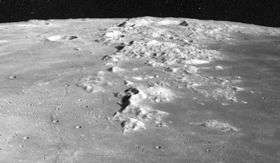
Montes Caucasus
Montes Caucasus is a rugged range of mountains in the northeastern part of the Moon. It begins at a gap of level surface that joins the Mare Imbrium to the west with the Mare Serenitatis to the east, and extends in an irregular band to the north-northeast to the western side of the prominent crater Eudoxus. The range forms the northwestern boundary of the Mare Serenitatis. It forms a continuation of the Montes Apenninus range to the southwest.
There are several breaks in the range where nearby lunar mare has intruded into the formation, particularly near the southern tip. Embedded within the eastern flank of the range is the crater Calippus. Along the eastern flank to the south of Eudoxus is the remnants of the crater Alexander.
The selenographic coordinates of this range are 38.4° N, 10.0° E, and it has an official diameter of 445 km. However some observers list the length as being up to 550 km. The tallest peaks in this range reach heights of 6 km, undoubtedly providing an expansive view of the surroundings from their tops.

Caucasus
The Caucasus /ˈkɔːkəsəs/ or Caucasia /kɔːˈkeɪʒə/ is a region at the border of Europe and Asia, situated between the Black and the Caspian seas.
It is home to the Caucasus Mountains, which contain Europe's highest mountain, Mount Elbrus, 5,642 metres (18,510 ft). Politically, the Caucasus region is separated between northern and southern parts. The southern parts consist of independent sovereign states, and the northern parts are under the jurisdiction of the Russian Federation.
The region is known for its linguistic diversity: aside from Indo-European and Turkic languages, the Kartvelian, Northwest Caucasian, and Northeast Caucasian families are indigenous to the area.
Name
Pliny the Elder's Natural History (AD 77–79) derives the name of the Caucasus from the Scythian kroy-khasis (“ice-shining, white with snow”).
Throughout Persian history, particularly Sassanid Persia, the Caucasus region was the furthest point of Persian expansion, with areas to the north of Northern Caucasus practically impregnable. Therefore, the mythical mountain of Cafcuh, the highest mountain in the world, was said to be situated in this region, making the Caucasus the limit of the world. Therefore, the Caucasus was the name given to this area for its association with the legendary mountain. The modern name of the region in local languages are all similar to the mountain name, with the main difference being that f has been replaced with a softer w and the last letter being replaced with z.

Caucasus Mountains
The Caucasus Mountains are a mountain system in Eurasia between the Black Sea and the Caspian Sea in the Caucasus region.
The Caucasus Mountains include the Greater Caucasus Range, which extends from the Caucasian Natural Reserve in the vicinity of Sochi on the northeastern shore of the Black Sea, aligned west-northwest to east-southeast and reaching nearly to Baku on the Caspian Sea; and the Lesser Caucasus, which runs parallel to the greater range, at a distance averaging about 100 km (62 mi) south. The Meskheti Range is a part of the Lesser Caucasus system. The Greater and Lesser Caucasus ranges are connected by the Likhi Range, which separates the Kolkhida Lowland from the Kura-Aras Lowland. In the southeast the Aras River separates the Lesser Caucasus from the Talysh Mountains which straddle the border of southeastern Azerbaijan and Iran. The Lesser Caucasus and the Armenian Highland constitute the Transcaucasian Highland, which at their western end converge with the highland plateau of Eastern Anatolia in the far north east of Turkey. The highest peak in the Caucasus range is Mount Elbrus in the Greater Caucasus, which rises to a height of 5,642 metres (18,510 ft) above sea level. Mountains near Sochi hosted part of the 2014 Winter Olympics.

Caucasus (Fabergé egg)
The Caucasus Egg is a jewelled enameled Easter egg made by Michael Perkhin under the supervision of the Russian jeweller Peter Carl Fabergé in 1893. The egg was made for Alexander III of Russia, who presented it to his wife, the Empress Maria Feodorovna.
Currently the egg is a long term installation at the Metropolitan Museum of Art in New York City, New York, as part of the Matilda Geddings Gray Foundation.
The Egg
The egg is made of yellow and varicoloured gold, silver, ruby enamel, rose-cut diamonds, portrait diamonds, platinum, ivory, pearls, rock crystal and watercolour on ivory.
It commemorates the Imperial hunting lodge in Abastumani in Caucasus where Grand Duke George spent most of his life after being diagnosed with tuberculosis. Miniatures were done and signed by Krijitski. The miniatures are revealed by opening four pearl-bordered doors around the egg. Each door bears a diamond-set numeral of the year, forming the year 1893. Behind the hinged cover at the top is a portrait of the Grand Duke in his naval uniform.
Podcasts:

